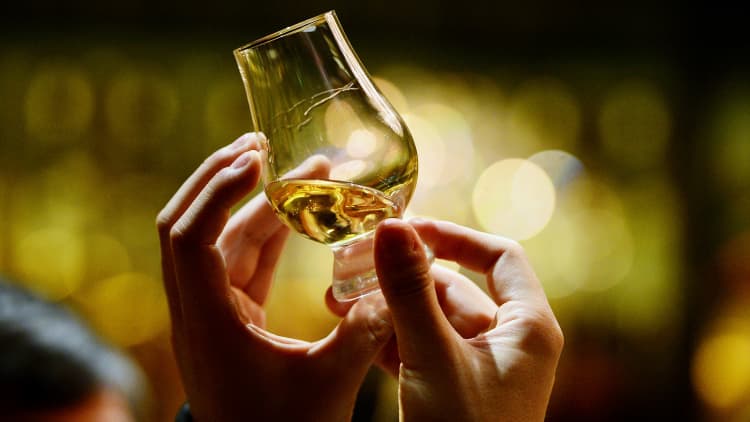Wednesday may be National Scotch Day, but the American spirit is taking over. Sales of U.S. made whiskeys — things like Kentucky bourbon and Tennessee whiskey — are outpacing other types, including Scotch. So whisky makers in Scotland (where they spell it without the "e") are trying to get themselves off the rocks.
"Everybody's trying to do something a little different to increase the number of 'expressions' on the shelf for their brand," said Ray Pearson, a brand ambassador for various Scotch whiskys.
According to the Distilled Spirits Council of the United States, the overall spirits market is growing, with sales growing 4 percent last year to $72 billion. Hard liquor continues to take market share from beer. The most interesting news is that the biggest growth is high-end sales. Bottles over $20 now account for a fifth of total liquor volume in the United States.
While whiskey had another good year, it was due in large part to sales of "brown spirits" like bourbon, which grew much faster than Scotch whisky. Bourbon and Tennessee whiskey are catching on overseas, as exports topped $1 billion for the third year in a row. Irish whiskey "continues to explode."
QUICK LESSON ON WHISKEYS:

Scotch whisky is made from malted (toasted) barley, water and yeast. It is distilled twice and aged in used barrels, usually bourbon or sherry barrels. A single malt whisky comes from a single distillery, versus a blend like Johnny Walker, which comes from several Scottish distilleries. Blended whisky remains far more popular than generally more expensive single malts.
Irish whiskey is similar but distilled three times.
Bourbon is almost entirely made in Kentucky, mostly from corn, and it has to be aged in new oak barrels. In other words, barrels are only used once and then usually sold to other whiskey makers.
Tennessee whiskey is like bourbon, except after it's distilled, the liquid is filtered through charcoal.
There are also whiskeys made mostly from rye, and Canadian whisky can be a blend of many things.
Pearson said Scottish distilleries are trying to promote Scotch sales with an increasing number of brand ambassadors. Many distilleries are now selling single malts that have no age on them, to give them more flexibility in creating flavors. Levels of peat in the malting process are being varied to provide different results. Still, he said, "there's a lot more experimentation in the bourbon area than there is in the Scotch area."
BARREL BUST?
Nothing impacts the flavor more than the wood in the barrel. While bourbon can only be aged in new barrels, Scottish distilleries will reuse those old barrels up to three or four times to make Scotch. Refurbishing those barrels is a huge business, heavily dependent on casks being shipped across the Atlantic from Kentucky and Tennessee.
Why is U.S. whiskey only aged in new barrels? It goes back to an old law when Prohibition ended, a law many believe was intended to generate jobs for barrel makers, called "coopers." Finding new wood every year can be expensive, and there has been talk — quickly dismissed — of changing the law so barrels can be reused. "If it isn't broke, don't fix it," said Pearson.
Still, Scotch makers are keeping an eye on wood supplies. As fewer people drink sherry, some distilleries are making sherry on the side strictly for the barrels. In the U.S., Pearson said he knows of Scottish distilleries that bought tracts of land in the Ozarks to help provide bourbon makers with wood, "so that later on, they know exactly where this wood came from, because the wood is arguably the most important part of the whole thing."


